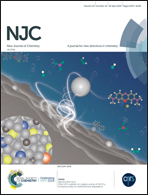Fabrication of polysiloxane foam with a pendent phenyl group for improved thermal insulation capacity and thermal stability
Abstract
A phenyl group was introduced into the polymeric network of polysiloxane foam for the improvement of its thermal insulation capacity and thermal stability. Phenyl-containing polysiloxane was prepared via ring-opening polymerization, and phenyl-containing polysiloxane foam was fabricated through simultaneous foaming and crosslinking reactions. With increasing phenyl content, the thermal conductivity of the polysiloxane foam decreased from 0.093 W m−1 K−1 to 0.079 W m−1 K−1. When the phenyl content was 6.15 mol%, the average cell diameter decreased from 384 μm to 165 μm and the cell density increased from 0.58 × 108 cells per cm3 to 4.67 × 108 cells per cm3. When the phenyl content was 8.5 mol%, the cell morphology became imperfect and the average cell diameter and cell density reached 259 μm and 1.29 × 108 cells per cm3, respectively. TGA results revealed the improved thermal stability of the polysiloxane foam. The TGA curves under nitrogen and air conditions could be divided into three stages. Under nitrogen conditions, the mass loss of the maximum decomposition stage decreased and the residue at 800 °C slightly increased. Under air conditions, the maximum decomposition temperatures of the three stages increased. The compressive strength and specific compressive strength were measured and showed a downward trend.



 Please wait while we load your content...
Please wait while we load your content...